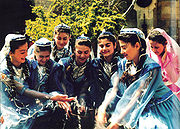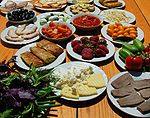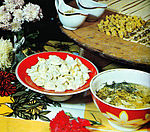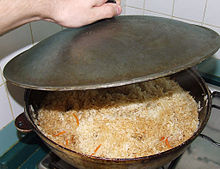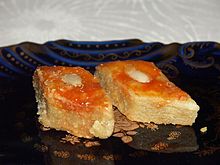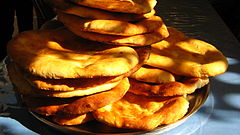- Azerbaijani cuisine
-
Part of a series on
Azerbaijani people
Culture Architecture · Art · Cinema · Cuisine
Dance ·Location of Azerbaijan
Azerbaijani cuisine refers to the cooking styles and dishes with origins in the nation of Azerbaijan and prepared by Azerbaijani people around the world. Throughout the centuries, Azerbaijani cuisine has been influenced by the foods of different cultures, though at the same time, it remained distinctive and unique. Many foods that are indigenous to the country can now be seen in the cuisines of other cultures. For the Azerbaijanis, food is an important part of the country's culture and is deeply rooted in the history, traditions and values of the nation.
Out of 11 climate zones known in the world, the Azerbaijani climate has nine.[1] This contributes to the fertility of the land, which in its turn results in the richness of the country’s cuisine. It is famous for an abundance of vegetables and greens used seasonally in the dishes. Fresh herbs, including mint, coriander, dill, basil, parsley, tarragon, leek, chive, thyme, marjoram, green onion and watercress, are very popular and often accompany main dishes. The Caspian Sea is home to many edible species of fish, including the sturgeon, Caspian salmon, kutum, sardines, grey mullet, and others. Black caviar from the Caspian Sea is one of Azerbaijan’s best known delicacies well sought after in other parts of the world, including former Soviet countries.
The main courses of Azerbaijani cuisine are over 30 kinds of soups, including those prepared from plain yogurt. One of the most reputed dishes of Azerbaijani cuisine, however, is plov from saffron-covered rice, served with various herbs and greens, a combination totally distinctive from Uzbek plovs. Azerbaijani cuisine includes more than 40 different plov recipes. Other second courses include a wide variety of kebabs and shashliks, including lamb, beef, chicken, and fish (baliq) kebabs. Sturgeon, a common fish, is normally skewered and grilled as a shashlik, being served with a tart pomegranate sauce called narsharab. Dried fruits and walnuts are used in many dishes. The traditional condiments are salt, black pepper, sumac, and especially saffron, which is grown domestically on the Absheron Peninsula.
Black tea is the national beverage, and is drunk after food is eaten. It is also a welcome beverage, often accompanied by fruit preserves.[2]
Contents
Light snacks
The Azerbaijani cuisine has a number of light snacks and side dishes to open or accompany the main meals: a plate of aromatic green leaves called goy, pieces of chorek (bread), choban (a tomato and cucumber salad), and sometimes white cheese or qatik (sour yoghurt).
Cold snacks are generally served separately from drinks.
Main dishes
File:Qutab.JPGQutab, made from thinly rolled dough that may be cooked briefly on a convex griddle.Main dishes may include a selection of the following:
Name Description Balıq Fish, which usually means sturgeon, normally skewered and grilled as a kebab, and served with a tart sour-plum sauce. Dolma The traditional recipe calls for minced lamb mixed with rice and flavoured with mint, fennel and cinnamon, and wrapped in vine leaves (yarpaq dolması) or cabbage leaves (kələm dolması), but most restaurants offering dolma tend to serve up stuffed tomato, sweet pepper and aubergine. There are also sour sweet cabbage dolma (turş şirin kələm dolması) and fish dolma (balıq dolması). Dushbara Small dumplings stuffed with minced lamb and herbs, served in broth. Lavangi A casserole of chicken stuffed with walnuts and herbs. A speciality of the Talysh region in southern Azerbaijan, but very difficult to find common in restaurants. Lyulya kabab A mixture of minced lamb, herbs and spices squeezed around a skewer and barbecued, often served with lavash (thin sheets of unleavened bread). Qutab A sort of pancake turnover stuffed with minced lamb, cheese or spinach. Tika kabab Chunks of lamb marinated in a mixture of onion, vinegar and pomegranate juice, impaled on a large skewer and grilled on the barbecue. In Russian, called шашлык, from Turkic shishlyk (literally, "for skewer"). Qovurma Pieces of mutton or lamb on the bone (blade chops) stewed with onions, tomatoes, and saffron.[3] There is also sabzi qovurma, a lamb stew with herbs. Sogan dolmasi The term dolma covers a variety of stuffed vegetable dishes, widespread in the Middle East and Mediterranean area. Onion dolma are a tasty winter alternative to stuffed aubergines, tomatoes and peppers.[4]
Soups
Name Description Piti The national soup of Azerbaijan made from pieces of mutton on the bone cooked with vegetables in a broth; prepared and served in individual crocks. Kufta bozbash A pea soup with lamb meatballs and boiled potatoes. The meatballs in kufta bozbash are large, hearty and made of minced lamb and rice, sometimes with a zesty dried plum inside. Sulu khingal Lamb soup with noodles Toyuq shorbasi Chicken soup Dovga A yoghurt (matsoni) based soup with sorrel, spinach, rice, dried peas, and small meatballs made from ground mutton; served hot or cold depending on the season;[5] Ovdukh A cold soup based on a matsoni–water mixture poured over sliced cucumbers, chopped boiled meat, quarters of hard-boiled egg, and greens (dill, coriander, basil, sometimes also mint and tarragon);[6] Dogramach Same as ovdukh, but without the meat;[6] Bolva Made with sour milk. Plovs
Plov is one of the most widespread dishes in Azerbaijan, with more than 40 different recipes.[2] Plovs have different names depending on the main ingredient(s) accompanying rice:
Name Ingredients Kourma plov Mutton, onion Chilov plov Bean plov with fish Sabzi qovurma plov Mutton Toyug plov Chicken Shirin plov Dried fruits Syudli plov Rice cooked in milk Sheshryanch plov Six-color plov, eggs cooked "sunny side up" on a bed of fried green and white onions[5] Azerbaijani plov consists of three distinct components, served simultaneously but on separate platters: rice (warm, never hot), gara – fried meat, dried fruits, eggs, or fish prepared as an accompaniment to rice, and aromatic herbs. Rice is not mixed with the other components even when eating plov.[7]
Desserts
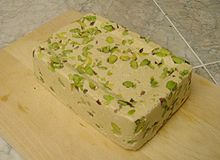 Pistachio halva
Pistachio halva
Typical Azeri desserts are sticky, syrup-saturated pastries such as pakhlava and halva. The latter, a layer of chopped nuts sandwiched between mats of thread-like fried dough, is a speciality of Sheki in North-West Azerbaijan. Other traditional pastries include shakarbura (crescent-shaped and filled with nuts), peshmak (tube-shaped candy made out of rice, flour and sugar) and girmapadam (pastry filled with chopped nuts).
However, sweets like this are generally bought from a pastry shop and eaten at home or on special occasions such as weddings and wakes. The usual conclusion to a restaurant meal is a plate of fresh fruit, plums, cherries, apricots, grapes, or whatever is in season.
In March 2009, Azerbaijani bakers achieved an entry in the CIS book of records for baking the biggest and heaviest pakhlava in the CIS, weighing about 3 tons. More than 7 thousand eggs, 350 kg of nuts, 20 kg of almonds, 350 kg of sugar, and the same amount of flour was used in the preparation of the pastry.[8]
Name Description Samani halva Samani halva, made from malted wheat, can best be described as a spicy, gooey, chewy treat.One samani halva tradition in Azerbaijan is to make halva communally, using flour from seven different homes.[9] Shekerbura Shekerbura (şəkərbura) are a popular Azerbaijani sweet pastry, filled with ground almonds, hazelnuts or walnuts. Shekerbura, shor gogal and bakhlava are all eaten in Baku at the Novruz spring holiday.[10]
Bread
Tandoor bread is a type of bread baked in a clay oven called a Tandoor.[11][12]
Drinks
Sherbets
An Azerbaijani sherbet (Azerbaijani: şərbət) is a sweet cold drink made of fruit juice mixed or boiled with sugar, often perfumed with rose water. Sherbets (not to be confused with sorbet ices) are of Iranian origin and they may differ greatly in consistency, from very thick and jam-like (as in Tajik cuisine) to very light and liquid, as in Azerbaijan.[13] Sherbets are typically prepared in the following natural flavors:
Mineral water
Locally made brands of bottled water include the following:[15]
Brand Origin Originating area Aysu Badamlı Badamli, Nakhchivan Sirab Sirab, Nakhchivan Şollar Şollar village north-east Tamiz gazh su Qax Qakh district north[16] Kakh See also
- Azerbaijani wine
References
- ^ Climate zones of Azerbaijan
- ^ a b Based on the book Azerbaijani Cooking, Ishyg Publ. House, Baku (Russian)
- ^ Kourma recipe
- ^ [1]
- ^ a b Azerbaijan cookery by category of dishes, a section of Large Guide to Home Cooking (Russian)
- ^ a b Dogramach and ovdukh: recipes for Azerbaijani soups (Russian).
- ^ Interview with Jabar Mamedov, Head Chef at the "Shirvan Shah" Azerbaijani restaurant in Kiev, 31 January 2005.
- ^ "Huge pakhlava hits record in Ganja" on anspress.com. Retrieved on 17 March 2009
- ^ [http://www.news.az/recipes/24003
- ^ [http://www.news.az/recipes/33030
- ^ http://kabobcentral.com/tandoorbpage.html
- ^ http://www.malatyahaber.com/haberler/templates/malatya-new.asp?articleid=15738&zoneid=7&y=
- ^ Azerbaijani sherbets
- ^ a b Recipes for lemon and mint sherbets (Russian)
- ^ Mineral Waters of the World: Azerbaijan
- ^ Qakh or Kakh mineral water
External links
- Comparison of Cuisine between North and South Azerbaijan, Azerbaijan International, Autumn 2000, pp. 24–27.
- Proverbs about Food in Azerbaijan, Azerbaijan International, Autumn 2000, pp. 36–37.
- Food! Glorious Food!, Special issue of Azerbaijan International, Autumn 2000.
- Azerbaijani dishes: photographs and descriptions
- Azerbaijani cuisine: descriptions of dishes by category on advantour.com
- Cuisine of Azerbaijan based on the book Azerbaijani Cooking published in Baku (Russian)
- Selected recipes from Azerbaijani cuisine
- Farida's Azerbaijani Cookbook
- Azerbaijani Food
European cuisine Sovereign
states- Albania
- Andorra
- Armenia
- Austria
- Azerbaijan
- Belarus
- Belgium
- Bosnia and Herzegovina
- Bulgaria
- Croatia
- Cyprus
- Czech Republic
- Denmark
- Estonia
- Finland
- France
- Georgia
- Germany
- Greece
- Hungary
- Iceland
- Ireland
- Italy
- Kazakhstan
- Latvia
- Liechtenstein
- Lithuania
- Luxembourg
- Macedonia
- Malta
- Moldova
- Monaco
- Montenegro
- Netherlands
- Norway
- Poland
- Portugal
- Romania
- Russia
- San Marino
- Serbia
- Slovakia
- Slovenia
- Spain
- Sweden
- Switzerland
- Turkey
- Ukraine
- United Kingdom
- (England
- Northern Ireland
- Scotland
- Wales)
- Vatican City
States with limited
recognition- Abkhazia
- Kosovo
- Nagorno-Karabakh Republic
- Northern Cyprus
- South Ossetia
- Transnistria
Dependencies
and other territories- Åland
- Faroe Islands
- Gibraltar
- Guernsey
- Jan Mayen
- Jersey
- Isle of Man
- Svalbard
Asian cuisine Sovereign
states- Afghanistan
- Armenia
- Azerbaijan
- Bahrain
- Bangladesh
- Bhutan
- Brunei
- Burma (Myanmar)
- Cambodia
- People's Republic of China
- Cyprus
- East Timor (Timor-Leste)
- Egypt
- Georgia
- India
- Indonesia
- Iran
- Iraq
- Israel
- Japan
- Jordan
- Kazakhstan
- North Korea
- South Korea
- Kuwait
- Kyrgyzstan
- Laos
- Lebanon
- Malaysia
- Maldives
- Mongolia
- Nepal
- Oman
- Pakistan
- Philippines
- Qatar
- Russia
- Saudi Arabia
- Singapore
- Sri Lanka
- Syria
- Tajikistan
- Thailand
- Turkey
- Turkmenistan
- United Arab Emirates
- Uzbekistan
- Vietnam
- Yemen
States with limited
recognition- Abkhazia
- Nagorno-Karabakh
- Northern Cyprus
- Palestine
- Republic of China (Taiwan)
- South Ossetia
Dependencies and
other territoriesCategories:
Wikimedia Foundation. 2010.
Look at other dictionaries:
Cuisine of Azerbaijan — is considered one of the most delicious in the Caucasus region. Despite the fact that throughout centuries the country s food has been influenced by the foods of different cultures due to political and economic processes, today s Azerbaijani… … Wikipedia
Cuisine classique — is a style of French cookery based on the works of Auguste Escoffier. These were simplifications and refinements of the early work of Antoine Carême, Jules Gouffé and Urbain François Dubois. It was practised in the grand restaurants and hotels of … Wikipedia
Azerbaijani dances — Part of a series on Azerbaijani people Culture Architecture … Wikipedia
Cuisine — See also: Global cuisines, Outline of cuisines, and Regional cuisine Contents 1 History 2 Global and regional cuisines … Wikipedia
Cuisine of the Midwestern United States — Chicago style deep dish pizza … Wikipedia
Cuisine of the Thirteen Colonies — North American colonies 1763–76 The cuisine of the Thirteen Colonies includes the foods, eating habits, and cooking methods of the British colonies in North America before the establishment of the United States in the 1770s and 1780s. It was… … Wikipedia
Cuisine of the Mizrahi Jews — Further information: Jewish cuisine and Cuisine of the Sephardic Jews Iraqi Jewish cuisine: Kubbeh matfuniya The cuisine of the Mizrahi Jews is an assortment of cooking traditions that developed among the Jews of The Middle East, North… … Wikipedia
Cuisine of California — This article is about the local cuisine of California. For the style of cuisine identified with some famous Californian chefs, see California cuisine. Shrimp tostadas made with locally grown ingredients as served at Tacos Sinaloa in Oakland,… … Wikipedia
Cuisine of the Western United States — The Western United States has its own cuisine, distinct in various ways from that of the rest of the country.[1] Those states west of Texas, Kansas, Missouri, and Nebraska would be considered part of this area, as would, in some cases, western… … Wikipedia
Cuisine of the Americas — See also: North American cuisine and South American cuisine The cuisine of the Americas is made up of a variety of food preparation styles. North America North American cuisine consists of foods native to or popular in countries of North… … Wikipedia

